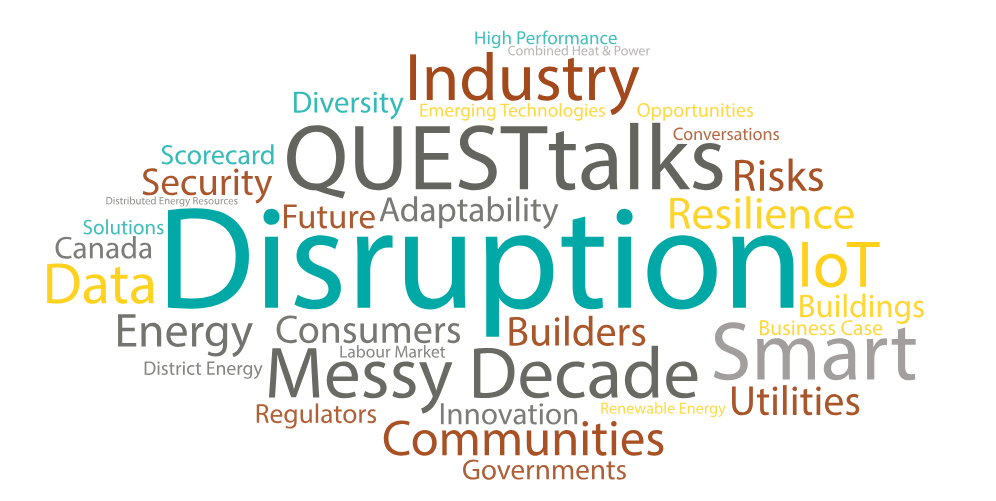Blog
Disruption & the Smart Energy Solution
Just about every global industry in the world today is grappling with unprecedented technology-driven disruption and upheaval. You could be in agriculture, or the music business or automotive industry and disruption would likely be front and centre in your conversations. Canada’s energy system is no different, disruption is driving change at a pace that has never been seen before in our industry. Hence, why disruption is the theme of our QUESTtalks series this year – Disruption and the Smart Energy Solution.
Our first QUESTtalk: Adaptability – Preparing Your Business for the Changing Energy Market, took place in Calgary, Alberta on April 18. It brought together over 70 leaders, experts, and students from government, industry, utilities and energy service providers, builders, owners and operators, and more. And we learned that every sector is experiencing similar challenges.

[dis-ruhp-shuh n] “to break apart, to throw into disorder, to interrupt the normal course or unity” ~ according to the Merriam-Webster Dictionary.

For more than 10 years, QUEST Chair, Michael Harcourt has stated that we would be entering a very messy decade and now today, we are on the cusp of it, and everyone servicing the energy sector is trying to understand their role. Delivering the opening keynote to the regulatory industry today at CAMPUT and drawing on what we heard in Calgary at QUESTtalks, Mr. Harcourt offered an overview of the pressures coming to bear on the regulatory decision-making process and the expectations of the various actors.
Consumers basic needs are still the same, they want their energy system to be reliable and safe, with infrastructure that is out of sight and out of mind, and they want it to be cheap. But increasingly they want to be more involved in decision-making, and they will increasingly expect to have access to and control over the data that utilities and energy companies keep about them.
In addition, a small, but significant group of consumers, are showing increasing interest in the idea of generating their own electricity and developers are responding to this demand by installing local energy delivery systems. But developers aren’t really interested in owning and operating local energy systems and regulated utilities aren’t currently able to own and operate them.
Governments, on the other hand, want to be seen to be acting on climate, while also keeping the existing resource economy humming, and keeping energy costs down. The federal government is keen to accelerate the low-carbon transition but it also recognizes that we will need to build the energy system of the future atop the resource economy of today. Federal and provincial governments have introduced carbon pricing and a variety of climate policies, but their long-term political viability remains to be seen. Meanwhile, local governments are increasingly building, owning, and operating local energy delivery systems.

Then there are the utilities. They recognize how the energy system is changing, and the change is leading to investment uncertainty. They need to maintain the system and upgrade it, and build new delivery systems to serve new communities and neighbourhoods. They want to remain competitive as new technologies such as solar and electric vehicles stand to reshape marketplace dynamics.
And on top of that, we are seeing disruption in public confidence or lack thereof in how we make energy infrastructure investments, to the role of the economic regulator balancing innovation and climate policy with affordability and reliability, to the growth of the prosumer and a distribution system moving from one way to two way to an open trading platform among end-users.
As all of these factors converge, and as we all work to understand how the Internet of Things and Artificial Intelligence will play a central developing role, a clear path forward for all is needed. However, with change comes an opportunity for savvy businesses to adapt quickly and reap the benefits of their subsequent competitive advantage. So what will Canada look like if we get it right? What future are we working toward? And how can your business adapt and get ahead?
Well, QUEST certainly doesn’t have all the answers, but we are confident that the focus needs to shift to performance and outcomes. We know that the future will look nothing like the past, and that energy systems of tomorrow are growing increasingly integrated and local today, and that electricity will likely play a stronger role than it does today over sectors of the economy that have traditionally relied on fuels. And we know that it’s best to be out leading to benefit from abundant opportunities than it is to respond to a whole new set of risks and unknowns.
That’s why QUEST is leading practical and informed discussions, conducting leading-edge research, and helping to inform policy and programs that will provide clarity for individual businesses, the development community, utilities, and cross-sectoral audiences as we forge toward the reality of Smart Energy Communities all operating with integrated energy systems.
Interested in the full summary from QUESTtalks: Adaptability? Join us, by becoming a subscriber, and get access to this report as well as advanced tools to help you succeed in the Smart Energy Communities marketplace such as QUEST’s working groups, marketplace research, discounts on our advisory services and events such as QUESTtalks: Resilience in Halifax on June 19 and QUESTtalks: Security in Toronto in October.
Sign Up
Join the Conversation!
Sign up to get the latest news and updates about QUEST Canada events and receive QUEST Canada's monthly newsletter.

